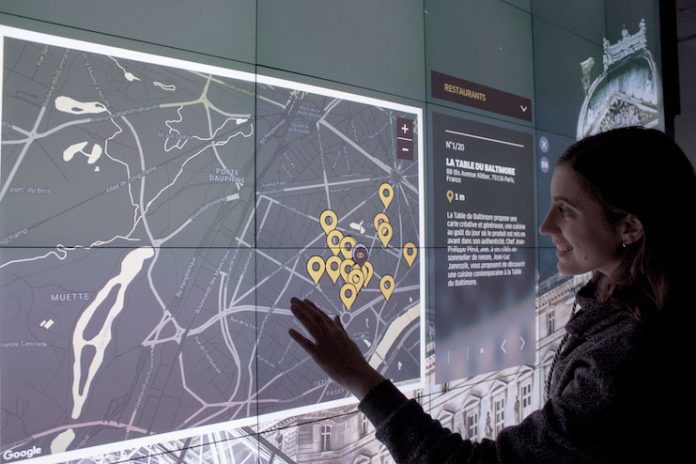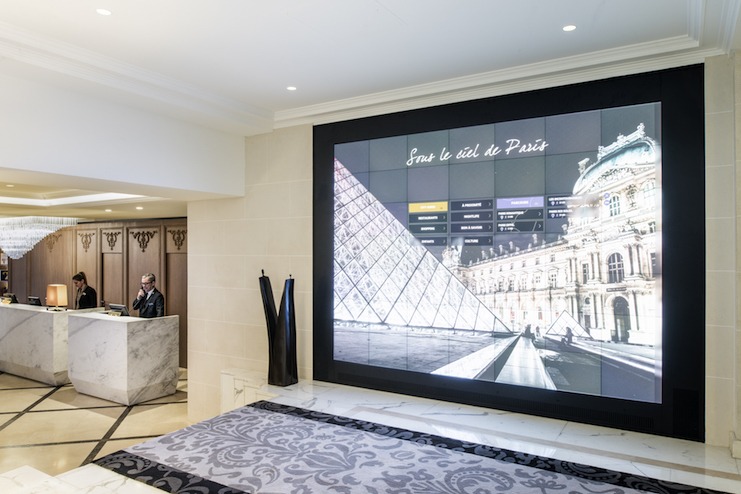
At its core, the hotel and hospitality industry is based on consumer engagement, relationship-building, and earned trust. Its existence relies on positive and memorable host-guest interactions. Smart interactions and connection opportunities increase the likelihood of a guest returning to a hotel or recommending a services. These interactions define the brand image and brand sentiment of a hospitality company.
Digital canvases, experiences, and installations are being woven into the fabric of physical spaces more and more often. The confluence of display, content, and interactive technologies over the past few years have contributed to the proliferation and normalization of these digital environments. They are applicable to a myriad of sectors and implemented for a variety of reasons. Within the hotel sector, digital canvases and smart technologies can be employed on two fronts—to elevate and amplify the identity of the property and to individualize and customize a guest experience.
The customization of an experience within the hospitality industry is not new; it‘s as simple as leaving a handwritten card with a basket of fruit in the room of an incoming guest. But to effectively maintain pace with other sectors embracing these technologies, how can hotel establishments integrate digital canvases and experiences into the woodwork?
When strategizing about the implementation of digital canvases in hotels, refer back to the industry’s driving force—connection, engagement, and relationship-building between people. With a digital canvas, the concept of connection broadens to include connection to a space, building, or even city.

Adding a digital canvas creates a variety of opportunities to connect guests to a brand. As a start, study a guest’s journey—from the airport or train station to the hotel, within the hotel, within a space, and their interactions with various services. From there, find windows of opportunities within those journeys to connect with them. They can range from a personalized, data-based experience at the front desk to artistic installations in a sauna room at a spa, or an interactive board in a lobby that showcases city-wide events.
Hotels and services should also identify what type of tech their guests are familiar with, and work interactions around them. Ease of use is important, and integrating familiar tech such as mobile screens and applications can be an effective method of engagement that also eliminates the need for an introduction or learning phase.
Integrating a digital experience or a digital canvas into a space is an investment, and technology is evolving at an incredibly fast rate. To reduce risks and maximize returns, be sure that these digital elements are a necessary part of the guest’s desired journey and that they align with brand goals and values. Digital canvases should enable a solution and elevate an opportunity, or else risk spending needlessly on a trend that won’t appeal to a brand’s masses.
In addition, digital canvases should not replace the human experience. The hospitality industry relies on personal connections, and eliminating the humanity that comes with service is disadvantageous. Instead, think about how a digital canvas can make the jobs of industry and service workers more efficient, or how it can increase the opportunities for guest and staff to connect with each other. Incorporate the staff within the experience a digital canvas can provide.
Once goals and windows of opportunities are found, decide on the content that will be shown or the interaction that will take place. From there, choose the right technical tools to power the content on the designated digital canvas, whether it’s the latest content management system server, a simple TV screen, or a mobile app.
The integration of digital canvases and installations in the hospitality industry should enhance a sensory experience. At the end of a guest’s journey, what matters is how and why the experience was implemented, and if it was memorable, comfortable, and enjoyable.











